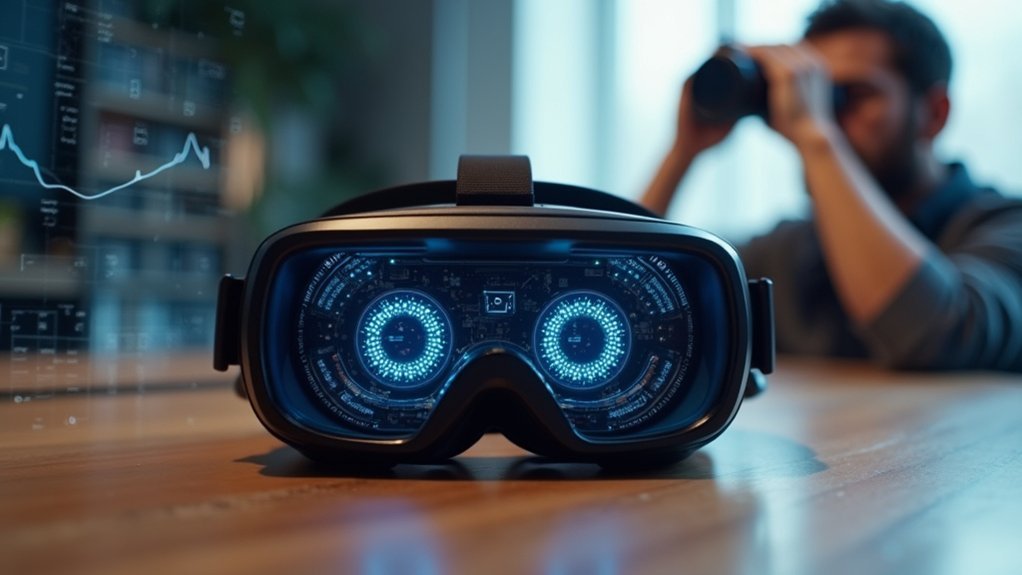To optimize your VR eye tracking experience, position your headset for clear infrared sensor sight lines and calibrate before each session. Choose applications that utilize foveated rendering and advanced gaze features. Review privacy settings to manage data collection from your behavioral patterns. Prepare for deflectometry technology that’ll capture over 40,000 eye surface points within 2-5 years. Expect real-time gaze-based controls to replace traditional interfaces. These strategies will reveal the full potential of tomorrow’s sophisticated tracking systems.
Optimize Headset Positioning for Maximum Tracking Accuracy

While eye tracking technology in VR has advanced greatly, you’ll only achieve best performance when your headset sits correctly on your head.
Position your VR headset so it rests comfortably and securely, guaranteeing infrared sensors have clear sight lines to your eyes. This positioning directly impacts tracking accuracy and responsiveness.
Proper headset positioning ensures infrared sensors maintain unobstructed eye contact, directly determining your VR tracking precision and system responsiveness.
Adjust the eye relief by moving the headset closer or farther from your face until you achieve sharp, clear visuals.
This distance optimization enhances your eye tracking tech’s effectiveness markedly. Keep the lenses spotlessly clean, as smudges or obstructions interfere with sensor performance.
Don’t forget to calibrate the system following manufacturer guidelines—proper calibration guarantees precise gaze detection.
Maintain consistent lighting throughout your session, since varying conditions affect infrared sensor performance and compromise tracking quality.
Calibrate Your Eye Tracking System Regularly
After achieving ideal headset positioning, you’ll need to calibrate your eye tracking system regularly to maintain peak accuracy.
Most systems recommend calibration before each session, as slight changes in eye anatomy or headset positioning can greatly impact performance.
The calibration process typically involves following visual prompts on screen, allowing the system to record specific data points for precise tracking.
High-end VR technology like HTC and Varjo headsets often feature automatic calibration processes that enhance user convenience.
Regular calibration isn’t just about precision—it actively reduces latency and improves comfort, especially in dynamic VR environments.
Even minor shifts in your headset can throw off eye tracking accuracy, making consistent calibration essential for optimal virtual reality experiences.
Choose Applications That Leverage Advanced Eye Tracking Features
You’ll maximize your VR experience by selecting applications that harness cutting-edge eye tracking capabilities rather than settling for basic implementations.
Look for software that incorporates foveated rendering, which dramatically improves visual quality while reducing system strain by rendering only what you’re directly viewing in full detail.
Consider exploring medical applications that use eye tracking for diagnostic purposes, as these represent some of the most sophisticated implementations of the technology available today.
Foveated Rendering Benefits
When you’re choosing VR applications that support foveated rendering, you’ll want to prioritize those that can dynamically adjust graphics quality based on your eye movements at frequencies exceeding 200 Hz. This technology transforms user experiences by concentrating computational power where you’re looking while reducing rendering workload in your peripheral vision.
| Feature | Traditional Rendering | Foveated Rendering |
|---|---|---|
| Frame Rate | 60-90 FPS | 120+ FPS |
| GPU Load | 100% | 40-60% |
| Latency | 15-20ms | 8-12ms |
| Visual Quality | Uniform | Optimized |
| Battery Life | Standard | Extended |
Eye tracking accuracy of 0.5 degrees guarantees precise adjustments, accounting for subtle gaze shifts. You’ll notice smoother gameplay and more immersive training simulations, as foveated rendering greatly improves performance while maintaining visual fidelity where it matters most.
Medical Diagnostic Applications
Healthcare professionals are leveraging high-frequency eye tracking systems to revolutionize diagnostic capabilities, particularly for neurodegenerative conditions where traditional assessment methods often fall short.
You’ll find that eye tracking technology enables remote diagnostics for Parkinson’s disease and Alzheimer’s disease by analyzing specific gaze patterns that reveal cognitive impairments. Advanced systems operating above 200 Hz provide real-time patient monitoring, greatly enhancing assessment accuracy and treatment precision.
You can detect subtle changes in eye movements that indicate fatigue or distraction, making this technology invaluable for mental health monitoring and cognitive load assessment.
Medical diagnostics benefit tremendously from these detailed insights during drug development and clinical trials, where patient reactions and engagement levels are essential.
Telehealth services you’re using can now tailor interventions based on individual gaze behavior, improving patient outcomes.
Understand Privacy Settings and Data Collection Policies
Since eye tracking technology captures far more than just where you’re looking, understanding privacy settings becomes vital for protecting your personal data in VR environments.
Eye tracking reveals intimate behavioral patterns beyond simple gaze direction, making robust privacy controls essential for VR users.
You should actively explore privacy settings within VR applications to control how your eye tracking data gets collected and used. Make sure you understand each company’s data collection policies before consenting to eye tracking functionalities.
Look for options that allow data anonymization, which removes personally identifiable information from your behavioral insights.
You’ll want to know exactly how companies collect, use, and share your eye tracking data. Stay informed about your privacy rights under current regulatory frameworks, as data protection laws continue evolving.
Don’t skip reading consent forms – they reveal significant details about what you’re agreeing to share.
Prepare for High-Resolution Deflectometry Technology
As VR technology advances, you’ll soon encounter deflectometry-based eye tracking systems that capture over 40,000 points on your eye’s surface in a single image—a massive leap from current methods that typically track just a dozen points.
This deflectometry technology projects light patterns onto your eye and captures reflections with standard cameras, creating detailed 3D maps of your eye’s shape for precise gaze detection.
You should prepare for algorithms that analyze light pattern curvature to reconstruct your eye’s shape in real-time. These real-time applications can detect fatigue, distraction, or medical issues based on gaze changes.
With commercialization expected within 2-5 years, this patent-pending technology will revolutionize VR gaming and biometrics, providing more intuitive interactions once miniaturization and cost challenges are resolved.
Adapt to Real-Time Gaze-Based Interface Controls
Beyond capturing detailed eye surface data, this advanced tracking technology enables you to control VR interfaces through natural gaze movements alone.
Real-time gaze-based interface controls transform how you navigate virtual environments by eliminating traditional controllers. With eye tracking systems operating above 200 Hz, you’ll experience responsive selection and navigation simply by looking at interface elements.
These adaptive systems create personalized experiences by analyzing your gaze patterns and adjusting content accordingly. The technology focuses processing power where you’re looking, optimizing performance through dynamic foveated rendering.
Advanced detection of saccades and microsaccades enables nuanced interactions that feel intuitive and natural.
You’ll find gaze-based controls particularly effective for menu selection, object manipulation, and spatial navigation, making VR interactions more immersive and accessible than ever before.
Stay Updated on Emerging Eye Tracking Research Applications
You’ll want to monitor breakthrough research that’s transforming eye tracking from entertainment into life-saving medical diagnostics for conditions like Parkinson’s and Alzheimer’s.
Remote research capabilities are expanding rapidly, allowing researchers to collect patient data through telehealth services that weren’t possible just years ago.
Advanced deflectometry technology now maps over 40,000 points on your eye’s surface, opening doors to real-time applications that’ll reshape both VR experiences and automotive safety systems.
Medical Diagnostic Breakthroughs
While virtual reality applications continue to expand across gaming and training, eye tracking technology is simultaneously breaking new ground in medical diagnostics that could transform how doctors assess and monitor patients remotely.
You’ll find that advanced eye tracking systems achieving over 200 Hz frequency and 0.5-degree accuracy can now detect early signs of Parkinson’s, Lyme disease, and Alzheimer’s through gaze pattern analysis.
When you’re developing VR technology applications, you’re contributing to real-time monitoring capabilities that identify fatigue, distraction, and cognitive changes.
This breakthrough enables healthcare professionals to conduct more accurate clinical trials by measuring participant engagement and cognitive load.
You’re witnessing the emergence of personalized medicine through adaptive training programs that’ll revolutionize patient assessment and treatment protocols.
Remote Research Capabilities
As virtual reality research expands globally, eye tracking technology enables you to conduct sophisticated studies from anywhere without requiring participants to visit physical laboratories.
You’ll leverage remote research capabilities that streamline data collection while maintaining scientific rigor. Modern systems deliver over 200 Hz frequency with 0.5-degree accuracy, ensuring precise user gaze analysis during VR sessions.
You can monitor cognitive load in training environments and enhance adaptive learning through real-time visual feedback. Eye tracking in VR also supports remote diagnostics for cognitive disorders like Parkinson’s and Alzheimer’s, expanding healthcare accessibility.
Systems like Varjo simplify integration with easy calibration and automated data recording. This technology transforms how you approach research methodology, eliminating geographical barriers while delivering high-fidelity insights into human attention patterns and cognitive processes.
Deflectometry Technology Advances
When deflectometry technology emerges from research labs into commercial VR systems, you’ll experience unprecedented precision in eye tracking that captures over 40,000 surface points on your eye in a single image.
Unlike current systems tracking only a dozen points, this innovation uses standard cameras and displays, eliminating expensive specialized hardware. You’ll benefit from detailed 3D eye mapping that accurately detects your gaze direction for seamless virtual navigation and interaction.
The technology also monitors eye characteristic changes that indicate fatigue, distraction, or medical issues.
With patents pending and commercialization expected within 2-5 years, VR companies will integrate deflectometry technology into gaming, augmented reality, and automotive applications, delivering more intuitive and responsive interfaces that revolutionize your virtual experiences.
Frequently Asked Questions
Is Eye Tracking Worth It in VR?
You’ll find eye tracking worthwhile in VR if you’re seeking enhanced graphics performance, intuitive navigation, and personalized experiences. However, you’ll need to weigh benefits against privacy concerns and current cost limitations.
How Do You Prevent Eye Damage From VR?
You’ll prevent eye damage by taking breaks every 20-30 minutes, adjusting brightness settings comfortably, maintaining proper headset distance, and using blue light filtering lenses if you wear glasses.
Can You Improve Eye Tracking?
You can improve eye tracking by upgrading to systems with 200+ Hz frequency, implementing dynamic foveated rendering, ensuring low latency operation, and exploring advanced deflectometry technology that maps thousands of eye surface points.
How Do VR Headsets Track Eye Movement?
Your VR headset uses infrared sensors and cameras to capture light reflections from your cornea and pupil. These systems track your gaze direction in real-time, processing data through algorithms for enhanced features.
In Summary
You’ll find that mastering these eye tracking fundamentals today sets you up for tomorrow’s VR breakthroughs. Don’t wait until the technology’s mainstream—start experimenting with proper calibration and positioning now. You’re getting ahead of the curve by understanding privacy implications and interface controls early. Keep monitoring research developments, and you’ll be ready when high-resolution deflectometry becomes standard. Your preparation today determines your VR success tomorrow.





Leave a Reply